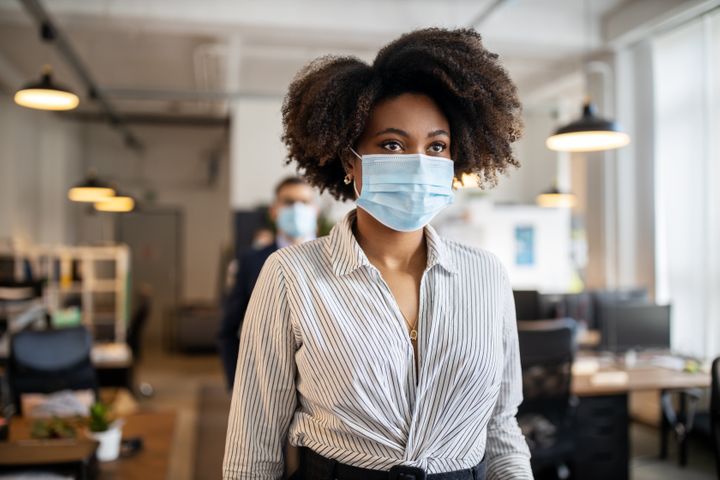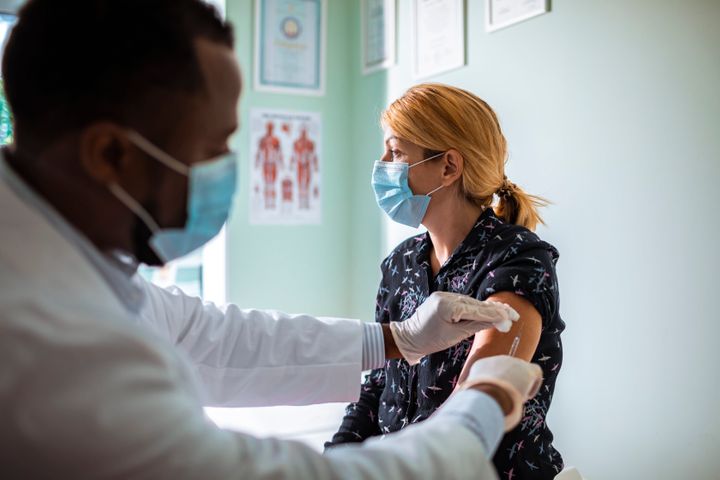News
The End Of The COVID-19 Pandemic Is Coming. Don
During a recent school drop-off, I heard several fellow parents talking about the upcoming February break. They were discussing whether they should get out of town to visit family or go somewhere warm. A few admitted in whispers that they were thinking about chancing it.
My older child is a New York City public school student who has been following a hybrid schedule since the fall, so he and his fellow in-person classmates come from families that have assumed a somewhat higher level of risk — as opposed to the 50% or more of families who opted to stay fully remote.
Still, these are caregivers I consider to be pretty cautious. Everyone wears masks. No one has been hosting indoor playdates or birthday parties. Over the winter holidays, most seemed to heed public officials’ pleas to avoid travel and get-togethers.
But now — thanks to vaccines and an administration that takes the pandemic seriously, among other things — people feel the end of the pandemic is tantalizingly close. I don’t blame us. Anthony Fauci, the United States’ top infectious disease doctor, predicted in December that we could reach herd immunity by this summer, and be back to some level of “normality” by the end of 2021. After nearly a year of profound uncertainty, the end appears to be in sight ― and it is so tempting to feel like we can finally let go.
But we absolutely, definitively, undoubtedly cannot.
Experts warn we are actually at a dangerous and pivotal moment ― a time where we must stay vigilant and committed to the prevention strategies we know work. This includes masks, of course, and certainly social distancing and eliminating non-essential travel.
Yet based on my eavesdropping, my own slipping resolve and the general temperature of society, so many of us don’t seem to grasp this. That includes public officials: Restrictions in some of the hardest hit areas, like California, are being rolled back. (One recent model suggests that loosening restrictions nationally in February could lead to an additional 29 million COVID-19 infections.)
“There’s definitely fatigue. We’re tired of staying in. We’re tired of staying at home. We’re tired of not eating out. We’re tired of missing holidays,” said Jonathan Leizman, chief medical officer at Premise Health. “As a matter of perspective … this is truly a once-in-a-century — perhaps once-in-four centuries — global pandemic that has impacted millions upon millions of people worldwide.”
And we cannot afford to go numb to that fact right now.
One simple reason for increased vigilance now is our botched national vaccine rollout. The federal government recently pledged to buy 200 million more doses in order to reach a goal of vaccinating 300 million Americans. Experts warn, however, that the promise of additional doses does not actually change the timeline for when most of us will be vaccinated. The best case scenario is that the majority of American adults could be vaccinated sometime this summer at the earliest, while other estimates suggest it is more likely to be next fall, or even later.
The emergence of several new COVID-19 variants has also led to some scrambling. These strains are likely more contagious, and some have been linked to higher levels of mortality (although it is not confirmed yet if that is actually the case). Our current vaccines are still protective against the new variants, but potentially less so, and both Pfizer and Moderna announced this week that they are working on booster shots to better target them.
The fact is, we already know most of what we need to know about protecting against the spread of these variants and others. And it all comes back to the same public health measures that experts have been trying to drill into American minds for months.
“If everyone stayed in their house, in a room, by themselves, no one would have coronavirus. Obviously that is completely unrealistic and not reasonable, but there has to be a happy medium where we as a society go, ‘OK, I’m going to keep social distance. I’m going to wear a mask. I’m going to wash my hands,’ there is a real ability to limit the spread of this virus dramatically — which we have not been doing,” said Eric Vail, director of the Molecular Pathology program with Cedars-Sinai in California. “If we don’t give the virus a chance to mutate, it won’t.”
What experts worry about now is the impact that time has had on Americans’ personal calculations about what is safe and reasonable to do during the pandemic, and what is too risky.
“If we do something and nothing bad happens, and then we do it again and nothing bad happens, our intuitive estimate of that risk goes down over time.”
Susan Joslyn, a professor of psychology at the University of Washington who studies how people make decisions in uncertain times, explained how we humans tend to use two cognitive systems when making choices. One is intuitive and not necessarily conscious; the is more deliberate and involves cost-benefit analysis. It’s the first system or process that she worries about most now.
“If we do something and nothing bad happens, and then we do it again and nothing bad happens, and then we do it again and nothing bad happens, our intuitive estimate of that risk goes down over time,” Joslyn explained. “It’s good for some things, but not for rare, very bad events — like contracting COVID.”
So we have to deliberately remind ourselves that just because we have not yet caught COVID-19 from, say, small social gatherings does not actually mean the outcome wouldn’t potentially be, as Joslyn put it, “very, very bad” if we one day did.
As the pandemic has worn on, the average age of those infected has shifted lower, suggesting younger Americans have a tendency to engage in this kind of distorted risk calculation. That kind of magical thinking also helps explain why millions of Americans still traveled over the winter holidays, despite being told emphatically to stay home.

The temptation to jump back into pre-pandemic routines will only continue to grow as more people get vaccinated, and finding a balance will be difficult.
“The next stretch is the hardest because we are in the midst of a range of emotions of both hope and fatigue,” said Priya Soni, a pediatric infectious disease specialist at Cedars-Sinai. “Some folks are vaccinated while others are not, the winter is still raging throughout the country, and until we find out more about the impact of the variants of COVID19 now noted, we are going to be in a state of confusion.”
Experts are cautiously optimistic that getting vaccinated means it is safe for individuals to get back pretty quickly to some level of normal, but there isn’t enough data yet to make a definitive conclusion.
“The vaccine is good at protecting against severe disease,” Leizman said. “We do not yet have enough data and information to conclude that it also significantly reduces transmission. I think there’s an assumption that is the case, but until we have more data we really need to make sure people are [getting] both doses of the vaccine, and that people are continuing to protect themselves and their loved ones by following those basic measures like wearing a mask.”
“The next stretch is the hardest because we are in the midst of a range of emotions of both hope and fatigue.”
So we are at a crossroads. If the vaccine rollout improves and more Americans finally adhere to simple protective measures like wearing masks, things truly could be back to some level of “normal” this fall. But if vaccination continues to be a challenge, as new variants spread among the quarantine-fatigued, experts warn our current crisis could be prolonged for months.
“Sitting here at the end of January 2021, we need to be prepared as a nation and we need to be prepared as individuals that this is going to continue for months and months to come,” Leizman said. “And we do not want to let our guard down now.”
Tragically for thousands of Americans, the end of the pandemic will come too late: Nearly 430,000 people have already died from COVID-19 in the United States.
Read more

